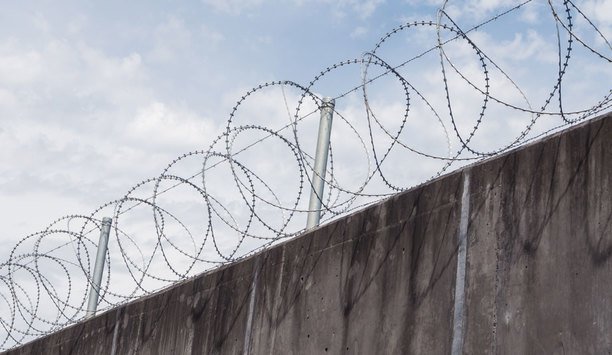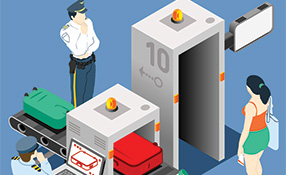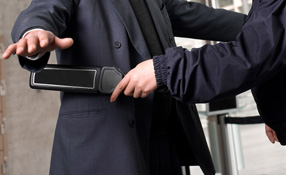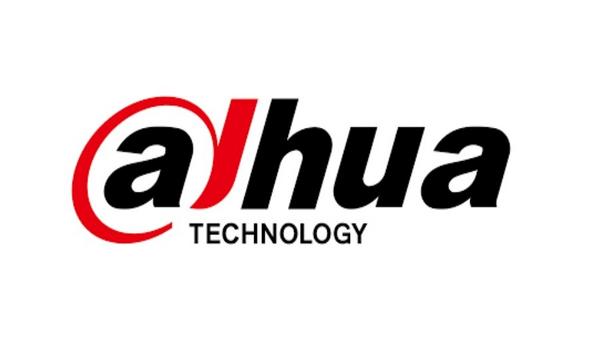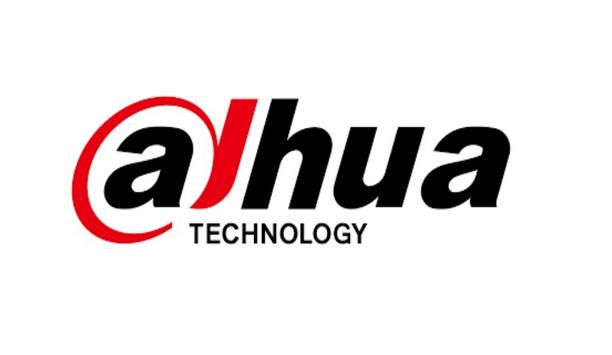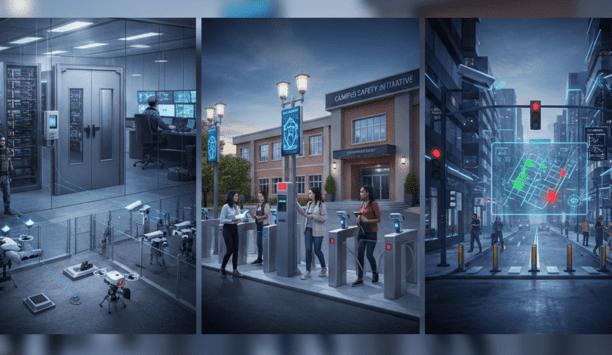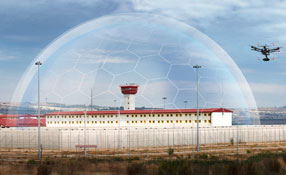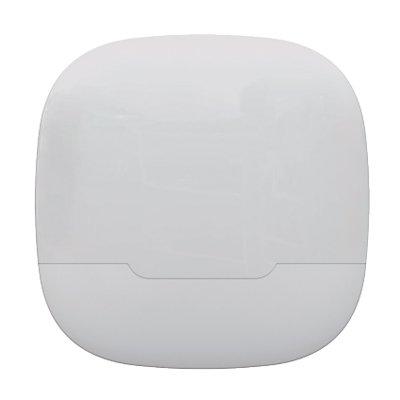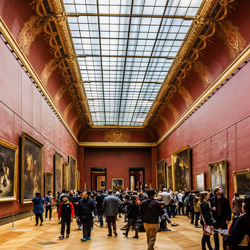 |
| With every technological advance that can benefit museum management comes another that may assist thieves |
When protecting art treasures, the first instinct for many security professionals may well be to look at recent advances in technology. Hasn’t the advent of IP-addressable devices provided sufficient tools to protect art exhibits from theft in a discreet manner? Apparently not, and entrenched attitudes abound among curators. Consultants who so much as mention RFID tagging in a museum environment often receive sarcastic responses reminding them that they have been asked to secure works of art – not pets or livestock.
There has, however, been a gradual acceptance of RFID in the art world, particularly if the tag is small enough to occupy only the head portion of the frame of a painting and not extend to the back. But it’s unusual for museum RFID tags to have GPS tracking, and they are rarely monitored beyond a distance of 70 yards. There is no downloadable “Where’s My Painting?” app on Android or iOS. Furthermore, RFID tagging of a frame provides no protection against thieves who are willing to take a blade to the canvas.
An application where RFID tagging and GPS come into their own is when items are sent on loan to other galleries and a travelling case is placed around the regular frame. The Kröller-Müller Museum in the Netherlands (known for its van Gogh collection) has recently adopted this technique. But even with such technology in place, art sector observers are disturbed by the risks inherent in what currently seem to be frenetic levels of activity, with galleries lending each other works as part of “inter-museum horse-trading.”
Motion detection
The video analytics lobby might point to the increasing reliability of intelligent scene analysis, but a confident thief placing a small painting in a shopping bag is not an easy scenario for an algorithm, and many types of legitimate behaviour near a painting can cause nuisance alarms. By contrast (even as a small source of comfort) it should be noted that removing an oil painting from its frame is not an easy matter and in this context “canvas” in the sense of cloth is a misnomer. Centuries-old lacquer makes many canvases as stiff as a board, and simple motion detection within a CCTV camera let alone analytics is likely to expose the hacking and sawing movements needed to cut away a painting.
Simple motion detection within a CCTV camera let alone analytics is likely to expose the hacking and sawing movements needed to cut away a painting |
Passive infrared sensor advantages
Passive infrared sensors (PIRs) have been the mainstay of protection at galleries since the 1950s and continue to be a vital tool, although ceiling height can be a limiting factor. The usual technique is to create a 4-inch deep “wall” in front of the painting by projecting downward from a ceiling-mounted detector. It was after leaning in to one of these “curtains” once too often at my favourite portrait gallery that I was finally persuaded to buy a pair of bi-focal glasses. I had been performing an elaborate ritual whereby I would come within inches of a work in order to read the information panel and then back off in order to view the whole painting. By this time an alarm had sounded or a visual alert unseen by me had attracted a guard. This odd to-ing and fro-ing among the middle-aged has been practiced by and named after one of Britain’s foremost playwrights; it’s known as “the Alan Bennett minuet.”
Steven Keller of Florida-based Architect’s Security Group is a consultant whose expertise includes museum protection. He argues that, ideally, an infrared curtain should be combined with a low railing in front of pictures projecting out some three feet. This will allow responsible visitors to lean over if necessary for a better view or perhaps to indicate a detail to a companion or student without setting off an alert. The infrared field can then be tight to the picture and nuisance alarms from legitimate visitor activity will be minimised.
A veteran of numerous gallery and museum installation projects, Keller makes the point that unless the wall being protected by an infrared alarm is very long – longer than the range of the detector – then the field of coverage will project into walkways or other areas where surveillance is not required. This difficulty can be solved by using two opposing detectors and wiring the devices so they must both trip before an alarm is generated, or terminating the detector into the wall before it extends beyond the desired area.
 |
| Passive infrared sensors (PIRs) have been the mainstay of protection at galleries since the 1950s and continue to be a vital tool |
Analytics better than infrared?
If a museum has suitable cameras then video analytics can become a viable alternative to projecting infrared beams in front of pictures. Areas that are prone to nuisance alarms can be masked off, and adaptive learning analytics can be “taught” that certain types of stimuli are not an attempt to steal the item but part of legitimate ambient activity.
Analytics can benefit museum curators more than infrared in so far as it may be possible to sound an alarm as soon as a sterile zone is compromised and prevent an incident whereas infrared will always be after the fact.
Access control for museum security
Access control has much to offer museums and, far from ignoring developments in this sector, galleries are beginning to adopt a technology that in no way compromises the safety of exhibits or visitor experience. It should be remembered that many of the access challenges presented to museum managers are in areas not seen by the public. MIFARE cards that can be deactivated at will must have solved many headaches for security directors worried that a former member of staff may pose a threat. Similarly, electronic key management (often using RFID) where traditional keys are issued on a hierarchical “right-to-have” basis creates accountability and protects paintings when they are in vulnerable locations such as a restoration studio. (Stringent access control for staff may have prevented many incidents: the FBI currently estimates that 80 percent of art crime is committed with the aid of an insider.)
Passive infrared is primarily useful in protecting exhibits from the clumsy or over-curious but it also deters thieves. A strategy intended specifically to defeat the art thief is a small wireless transmitter placed at the back of a painting and connected to an impact sensor. Unless they are exceptionally dexterous, anybody removing the painting from the wall will send a signal to an alarm panel in a control room, an off-site alarm receiving centre (ARC) or even to a smartphone app. These devices are of course reliant on a power supply in the control room and it would be interesting to know how many major art galleries have a back-up generator and how many take precautions against the possibility of thieves with electrical knowledge disabling entire power systems.
Saturation motion detection is |
Sadly, with every technological advance that can benefit museum management comes another that may assist thieves. (I can hardly be the first person to have looked at the roofs and perimeters of London’s art galleries on Google Earth.) The sheer volume of current security innovations must however be favouring the good guys; video management systems (VMS) companies are not only allowing motion sensors or video analytics to trigger recording but they can also programme their software to send clips (playable on a tablet or smartphone) to staff who are either off-site or elsewhere in a large building.
Understanding perimeter protection and motion detection
Perimeter protection manufacturers have much to offer the art sector. Nobody wants a museum to look like a fortress and many of the buildings are listed architecture whose façades cannot be compromised, but buried volumetric intruder detection is contributing to the security of numerous galleries. However, Steven Keller notes that perimeter protection provides no safeguard against the “stay behind” or against perhaps the most potent threat of all, the disaffected current or recent employee lurking in the building as was the case when ‘The Mona Lisa’ was stolen from the Louvre in 1911.
Keller says: “So many security designers, faced with a moderate budget, saturate galleries with motion detection rather than alarming every air intake vent in the room. While the intruder might not be immediately detected, he would eventually be apparent upon arrival in the collection-bearing area. Saturation motion detection is preferable to perfect perimeter protection since museum thefts can more easily occur by staying behind than by breaking in.” Keller is also at pains to stress that guards must also remain vigilant out of hours, and any security installation should be walk-tested every day at closing time in order to check functionality and flush out a “stay behind,” however remote this possibility may seem.
From facial recognition to LiDAR, explore the innovations redefining gaming surveillance




